Yesterday’s “Conversation on Unity in Christ’s Mission” between Francis Cardinal George and Evangelical author and former pastor John Armstrong was thoroughly enjoyable. The two men shared an obvious love for one another and for Jesus Christ. John spoke of being enriched by Catholic writers from long before the Reformation, who sound little like modern Evangelicals; Cardinal George spoke of the need for Catholics to learn a thing or two on preaching from Evangelicals. But despite the mutual respect and admiration, both men were forthright on the differences, and the things that still separate us. Chris Castaldo, an Evangelical ex-Catholic, was the host, and he asked good, substantive questions from justification, to mixed-marriages, to the way that each side understands Evangelization.
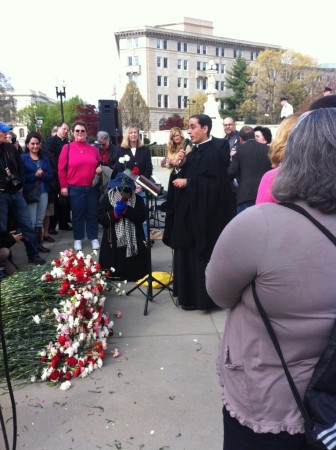 |
| Fr. Marcel in front of 3300 flowers, representing the daily death toll from abortion |
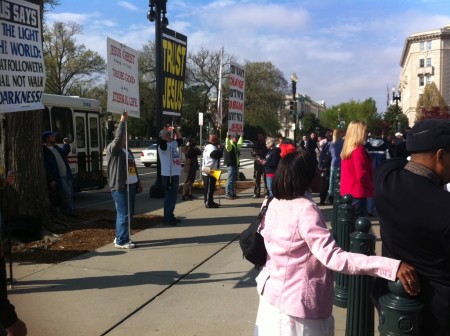 |
| The protesters. |
That’s not to say that this “ecumenism of the trenches” is without its malcontents. I encountered some of them at Encircle the Court. To set the stage a bit, Rev. Mahoney had asked we not bring signs, since this was about God, not politics. We weren’t protesters, per se: we were just concerned Christians and Americans who wanted to pray that God’s will be done. While we were praying around the court, we had the pro-Obamacare people in front of us, camped out and awaiting oral arguments. By the end, we had some actual protesters with signage arrive. The signs ranged from the generic to the offensive (like a sign with an upside-down American flag saying, “Jail to the Chief”). These protesters are part of a fringe of Evangelicalism that believes it’s immoral to even protest abortion along with Catholics. Being in between these two groups (literally) was fascinating, since both sides disliked us, but for opposite reasons.
After the Divine Mercy Chaplet, the leader of the protesters spoke to us through a megaphone, saying, “You’ve just taken two steps forward and four steps back. When you pray the Rosary, you’re praying to Mary, and you shouldn’t be surprised that God doesn’t hear your prayers.” No matter that we had just prayed the Divine Mercy Chaplet, not the Rosary; that there had been no prayers to Mary; and that Fr. Marcel had explained all of this a few moments before. The protesters were here to express disdain for Catholics, as well as for those like Rev. Mahoney who would stand alongside us.
At this point, Rev. Mahoney went back to his microphone and announced that these folks had nothing to do with us, asking that we not speak to them or engage them. By the time I left, it appeared that everyone had honored this request. It was clear that the protesters were just a fringe, and that the overwhelming majority of the Protestants there felt comfortable at least praying the Lord’s Prayer with us.
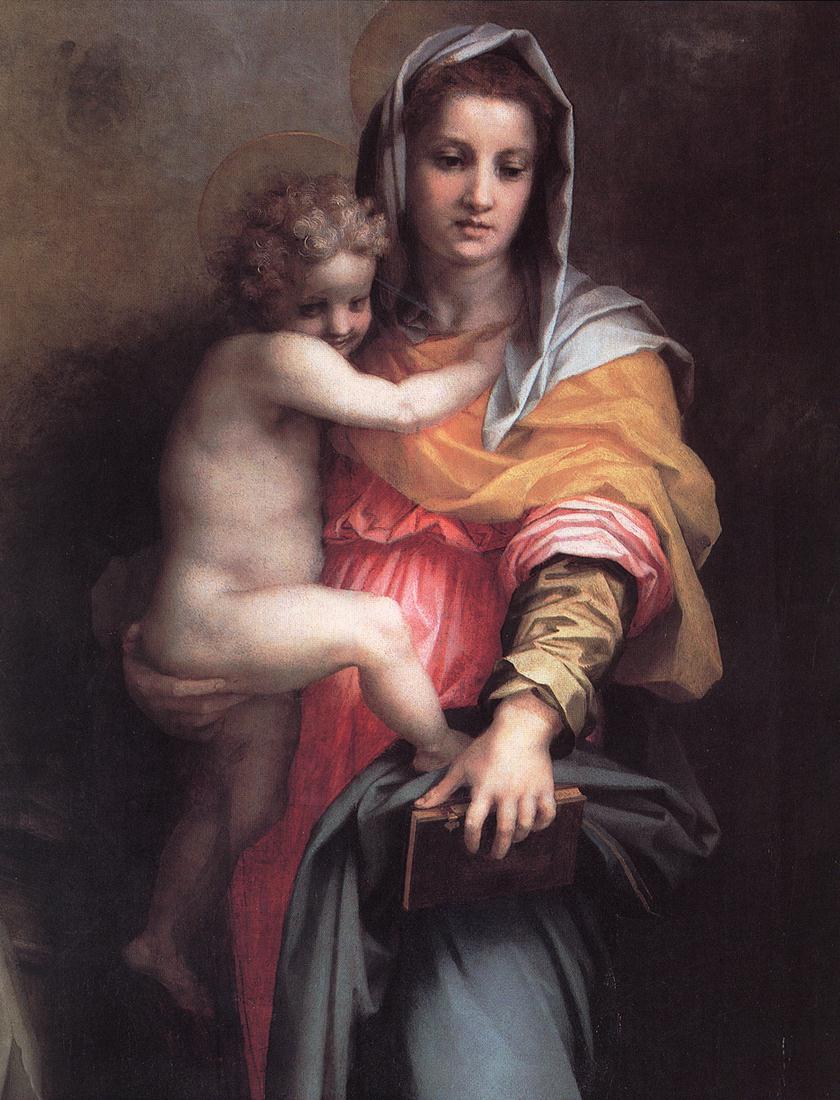 |
| Andrea del Sarto, Madonna of the Harpies (detail) (1517) |
It would be a mistake to view this as simply a marriage of convenience between two groups who will then go back to distrusting each other. On the contrary, as Tim Perry, author of Mary for Evangelicals, explains:
First, we must consider the impact of what Timothy George has called the “ecumenism of the trenches.” Over the last 35 years or so, evangelicals and Catholics have slowly come to appreciate how much we share in terms of morality, particularly in the thorny ethical problems surrounding the beginning and end of life, the definition of marriage, and the constructive role faith can and should play in the public realm. I think this has led to the establishment of grass roots friendships based on trust. To put the matter bluntly, theological disagreement takes on a whole new tone when you’re praying together in front of an abortion clinic. Key evangelical theologians and leaders like Timothy George, J. I. Packer, and Chuck Colson have used that trust wisely to engage in theological dialogue with Catholic theologians and leaders. Once such theological ties were established, it was only a matter of time before Mary came up. Since the third generation of the Reformation, she has personified every major doctrinal dispute, whether sola scriptura, sola fide, sola gratia, or solo Christo.
There is, I think, great reason to be hopeful. Evangelicals are increasingly feeling comfortable acknowledging Catholics as Christians, and recognizing a common faith. And this, as Perry acknowledges, is something of a first step that opens the doorway for authentic and meaningful Catholic-Evangelical dialogue. Given this, I would not be surprised if God heals the wounds of the Reformation using the Roe v. Wade backlash, rather than relying on the work of joint theological commissions.
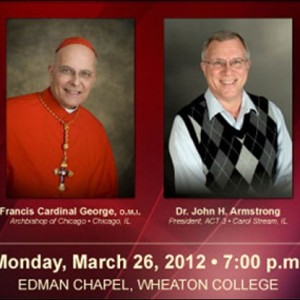
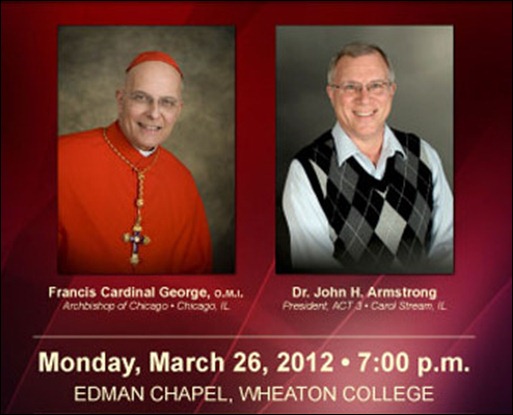
Great story, Joe. Of course, my SDA friends and family would say that this is one example of Protestants forsaking their heritage and wandering after the Beast. 🙂
Seriously though, I hate the sort of wariness of other Christians exemplified by the fringe protesters and am glad that they were the minority.
I’m largely in agreement. But to play devil’s advocate, isn’t there another side to this coin? It seems that accompanying this advance in charity is an evisceration of anything resembling a coherent ecclesiology. The evangelicals’ forbears, for all their faults, recognized the “trilemma of the Church,” as it were. They spat at the Church, which, bad as it is, is a more respectable position than indifference toward her. And so I wonder if this new charity is not the result of an increase in subjectivism and relativism in the evangelicals’ religion where anything goes but a few of their personal favorite doctrines.
A three-sided coin, Robert?
Metaphoric abuses aside, I think you’re right. A lot of the openness to Catholicism that I’ve seen has been in a fairly superficial sense: that Catholic devotions are just fine to incorporate into Evangelicalism, since Catholicism is just a different flavor of Christianity that some people happen to prefer. We’re the Guinness to their Bud Light: some find it heavy and oppressive, others like the richness. While that’s a fine way to understand devotionals, it’s entirely the wrong way to understand Catholicism. As you’ve said, it renders the Church irrelevant and harmless.
Of course, in writing the Church off as harmless, Evangelicals might finally be willing to sit down and listen to what She has to say.
Because let’s be honest: what came before was what we see with the fringe of protesters: a group of people who view Catholicism with such suspicion and disdain that they’re not willing to seriously consider that She might be right. Even if Evangelicalism flirts with superficiality (particularly with ecclesiology) today, I think it’s an overall improvement.
I.X.,
Joe
Whether or not that indifference of evangelicals is intellectually respectable, for practicable purposes I suppose I have to admit its a step in the right direction. After all just a couple years ago *I* would have told you that Catholicism should be treated as just another denomination. And that got me reading. And *that* is a very dangerous thing for a protestant to be doing.
And I was referring to the edge of the coin… obviously. (Edited to clarify who I was insulting).
I think if I ever was to describe the Catholic Church in terms of an alcoholic beverage it really would be Guinness…I mean, what else would you drink to honour Saint Patrick?!
Oh, and just an FYI, there was a really good critique of John Armstrong’s recent book on ecumenism over at Called To Communion:
http://www.calledtocommunion.com/2012/03/a-catholic-reflection-on-john-armstrong%E2%80%99s-your-church-is-too-small/
err… and here: http://catholicdefense.blogspot.com/2010/03/book-review-your-church-is-too-small-by.html
ah, 2010, the good old days of daily Protestant critiques… http://www.youtube.com/watch?v=78Ruh0ewBVo
Joe, this is incredibly fascinating. I am excited that the two “sides” are starting to see they are apart of the same coin.
In light of Fr. Marcel’s non-suspension suspension, is leading a public devotion appropriate?
Restless Pilgrim, that was a Devin Rose guest post. I was thrilled when I saw it (John Armstrong + Devin Rose + Called to Communion… how could I not enjoy it?). John responded, by the way.
Erin, agreed! I’m always amazed at the means that God uses to accomplish His Will.
Daniel, I’m no expert, and for that reason (amongst others), have tried to avoid wading in to the whole mess.
I suspect that he was fine, canonically-speaking (a layperson could lead the rosary and Chaplet of Divine Mercy, so it seems well afield of the priestly faculties that were suspended).
I can’t speak to the prudence of the issue, but I can say that when Rev. Mahoney began to say something about the way that Fr. Marcel had been treated, Father immediately cut him off, and put an end to that line of idle chatter.
Speaking of prudence, let me reiterate that I have limited knowledge about the circumstances, and that many of the people idly chattering do, too. So I’m rather hesitant to jump into the whole issue.
I.X.,
Joe
Bud Light?! Ouch Joe! You could’ve at least given them a decent craft beer like Sierra Nevada or Blue Moon. 🙂
@CJ, given just HOW MUCH is missing from Evangelicalism compared to the fullness of the Faith, some denominations might only qualify as Budweiser 55.
Every time I read about the “similarities between Catholics and Evangelicals” I can’t help but think that it is more about “things Evangelicals retain despite centuries of split from the Church.” We have nothing in common except what the Church has always taught.
Still, whatever means to get people to actually learn what the Church teaches is fine by me.
Hey Joe, funny connection–Chris Castaldo was a pastor at College Church of Wheaton where my parents go and where Paige and I met. I’m thinking about picking up his “Journeys of Faith” featuring commentary by Anglicans, Catholics, Eastern Orthodox and Evangelicals.